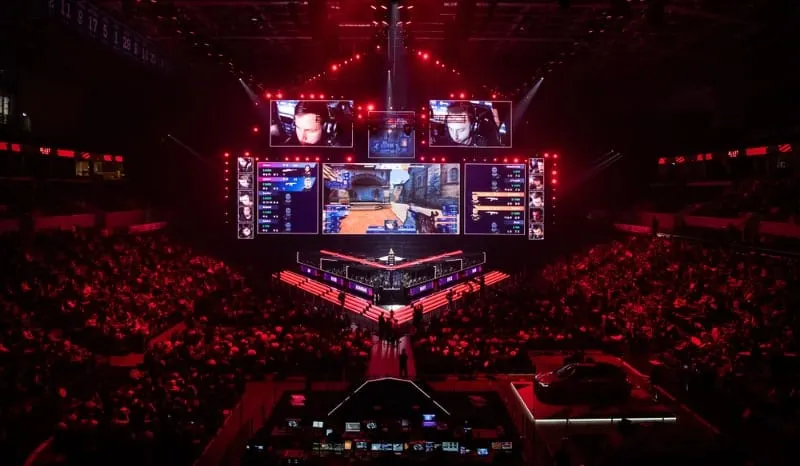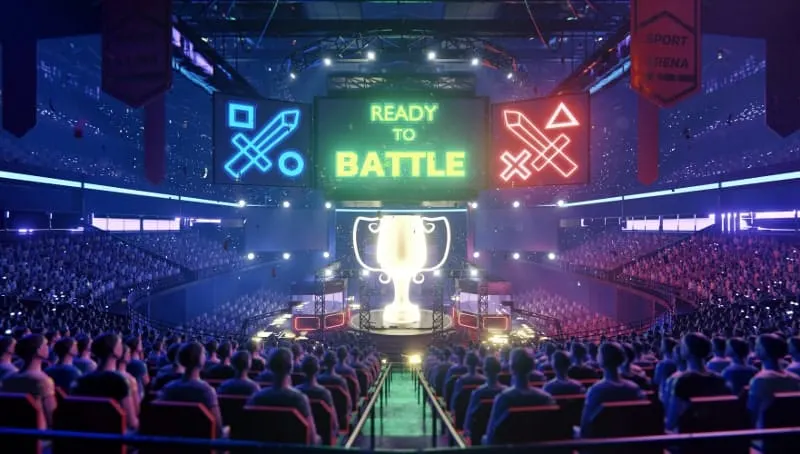Electronic sports have been around since the 1970s, but they really took off in the 1990s and exploded in the 2000s.
Gaming has evolved from a casual pastime to a professional sport.
Professional competitive gaming, also known as eSports, is now a multibillion-dollar industry. Sold-out arenas, a rabid fan base, sponsorships, and even a possible Olympic debut are all on the cards.
As you can see, eSports shows no sign of slowing down. In fact, it’s only going to get bigger.
So, if you feel like this global phenomenon “came out of nowhere,” and you’re curious about what it all means, here’s your eSports beginner’s guide.
GUIDE TO eSPORTS: EVERYTHING YOU NEED TO KNOW
eSports has recently grown in popularity, and the community has become less niche. The prize pools are approaching those of mainstream sports, and the entire industry has grown to be worth billions of dollars.
Naturally, this has piqued people’s interest.
E-what? What is this eSports thing even? Where did it come from? Who plays eSports? People at home in sweatpants?
Let’s start with the most basic question in our eSports primer.
What are eSports?
If you look up the definition, you’ll find that eSports (or electronic sports) is computer gaming played at a skilled and competitive level.
That is where the most common misunderstanding is addressed. eSports isn’t just about people playing video games; it’s about people who are good at them.
Daigo Umehara, who currently holds the world record for the most successful player in major Street Fighter tournaments, is famous not for playing 3S but for being the best at it.
In most ways, eSports is similar to traditional sports. It has its own set of rules, objectives, and players with “a very particular set of skills,” as Liam Neeson put it.
Tournament structures, player contracts, professional teams, sponsorships, commentators, and televised events are all features of eSports, just like they are in basketball or football.
Before you ask, “Why would anyone watch that?” remember that golf is broadcast on television.
Some games are played in a one-on-one format, but the majority of popular esports are team-based. eSports are played in leagues or tournaments throughout the year, culminating in a single final event to determine the overall championship.
These tournaments can range from local matches to sold-out stadiums or eSports-specific venues.
Competitors face off in team games like League of Legends, Dota 2, CS: GO and Overwatch; or solo games like Street Fighter and Hearthstone to name a few.
These gamers might not be household names, but they’re rock stars in the gaming world.
They’re watched and followed by millions of fans all over the world, who attend live events or tune in on TV or online.

Moscow, Russia, 2018 | Roman Kosolapov
A brief history of eSports
The earliest known video game competition took place on October 19, 1972, at Stanford University – the Intergalactic Spacewar Olympics. Soon after, the arcade craze took hold and video game competitions hit the mainstream.
It was in 1980 that the very first Space Invaders Championship was held by Atari, and it was the earliest large-scale video game competition with more than 10,000 participants.
Leading into the 90s, competitive gaming only picked up the pace, kicking off with the Nintendo World Championships.
However, the internet, like every other industry, changed everything. In the 1990s, as computers became more affordable and powerful, PC gaming was on the rise.
With the advent of the internet, gamers were able to compete against one another, and a community began to emerge that would later shape competitive gaming into eSports.
Quake’s 1997 Red Annihilation tournament is credited with launching eSports as we know it. Two thousand gamers competed online in what has become known as the “Woodstock of gaming.”
Everything was in place for eSports to enter the new millennium.
In the year 2000, the Electronic Sports League (now ESL) was established. The World Cyber Games were held in Seoul the same year, and
Major League Gaming – the world’s largest eSports organization – debuted in 2002. That same year saw the release of Xbox Live, which brought online play to consoles.
Halo 2 was the first Major League Gaming game to be broadcast on national television in 2004.
eSports has since risen to prominence as the next major spectator sport. The final piece of the puzzle was the rise of live streaming platforms such as Twitch in the 2010s.
Twitch, which grew out of Justin.tv and is now owned by Amazon, allowed gamers all over the world to be their own broadcast network while also providing a platform for audience-broadcaster engagement.
Following that, sponsors and developers took tournaments to the next level, drew crowds, and established gaming as a lucrative career option.
And that, my friend, is how eSports grew from a minor niche to a multi-billion-dollar industry.
Who plays eSports?
“Where do I sign up?” you may be wondering. But don’t be fooled: professional gaming is more than just a hobby.
The best eSports players must put in a lot of effort and training. Pro players practice for more than ten hours a day to ensure that their combos, strategies, and shots are flawless.
Players might make hundreds of “actions” per minute, so they have to be able to multi-task extremely well. There is also a lot of competition; you are not only competing locally but also globally.
Success in eSports, as in any sport, necessitates skill, practice, and dedication.
HowStuffWorks explained it perfectly: The games require a head for tactics and strategy, the coolheaded know-how to make high-risk calls and the guts to follow through on them. Players must know their teammates’ (and opponents’) rhythms and styles, and sense when to seize the initiative and when to set up a teammate for the big play. These aren’t games of inches or yards, but contests in which mere milliseconds and paltry pixels mark the difference between victory and defeat.
And that’s what differentiates home gaming from professional eSports.

Johannesburg, South Africa, 2015 | Rich T Photo
Pro gamers are also their own breed of celebrity.
As I said, they are not household names yet, but they have devoted fans.
It’s also a lucrative career path; successful pro gamers rake in six-figure league salaries, if not millions. International competitions can offer substantial cash prizes as well as endorsement deals for participating teams.
Some of them also make some money on the side by hosting their Twitch streams or tutoring new players.
However, it isn’t a long-term career. Top players typically begin their professional careers at 16 or 17 and retire in their mid-twenties.
What is the most popular eSport?
It’s difficult to say which eSport is the most popular.
Are the most popular eSports the ones with the most players or the ones with the largest audience? Or maybe the ones with the most money on the line? It’s tricky.
So, let’s stick with the basics in our guide to eSports.
Here’s a quick rundown of some of the most popular eSports genres and games.
Fighting games
Most popular games: Street Fighter, Super Smash Bros., Tekken, Dragon Ball FighterZ
Fighting games pit two players or tag-teams against one another.
Since the days of arcades, these types of games have been a staple of tournaments.
They are also a great way to demonstrate your skill because there is no luck factor, one-on-one battles (exceptions do apply), and the general difficulty of the games.
First-person shooters (FPS)
Most popular games: Counter-Strike: Global Offensive, Battlefield, Overwatch, Halo, Call of Duty
FPS games, which are typically team-based events, emphasize the use of weapons and tactics to achieve strategic goals.
Fighting games are challenging because of their mechanics and the difficulty of using them, whereas FPS games are complex due to aiming and the pre-game.
The first-person shooter is also the most subdivided eSports genre.
The most popular is combining them with MOBAs, as in Overwatch and Rainbow Six Siege. Speaking of which…
Multiplayer online battle arenas (MOBAs)
Most popular games: League of Legends, DotA 2
MOBA games are the pinnacle of eSports difficulty. They require the reactions and accuracy of FPS games, as well as the combo game and character practice of fighting games.
At this point, some of the best MOBA players have essentially developed a sixth sense.
They can fill in mostly unknown data in a matter of seconds and check the stats of their entire team in the time it takes most of my readers to blink.
Real-time strategy (RTS)
Most popular games: StarCraft II, Warcraft III
RTS games are probably the least viewed and discussed of the bunch.
Predicting what your opponent will do requires a great deal of planning, forward-thinking, and foresight. It also takes a lot of practice to devise the ideal counter strategy for each type of strategy and player.
You could compare it to digital chess if you couldn’t see half the board when playing chess.
Conclusion
So, if there’s one takeaway from this eSports guide, it’s that the gaming world is frequently misunderstood.
Many media outlets like to harp on how “video games are evil and cause violence.” Hence, it’s only natural that they’d rail against those same games being played professionally as well.
Playing video games for a living is now a viable option. And why not? Call it nerd retaliation or whatever you want, but gaming is serious business.
So, the next time you hear someone telling a kid with big dreams that gaming is “not a real job,” please refer them to this article.

The world of eSports will thrive as long as there are open-minded people who understand the appeal, support, and watch the events.
If you haven’t already, you can join the millions of fans who support professional gaming on streaming platforms such as Twitch, Facebook Gaming, and Youtube Gaming.
Some of the more traditional viewers tune in to ESLGaming or Ginx TV to watch them. eSports events are frequently broadcast on ESPN 2, Disney XD, BBC, and TBS.
Some of the fans go on to make a living by streaming, which is also in the category of “said to be easy but really isn’t”, but that’s a topic for another article.
And with that, we bring our guide on how eSports evolved from Space Invaders to a global phenomenon to a close.
Keep an eye out. Things are just heating up.


